The next-gen MacBook Pro with Retina Display Review
by Anand Lal Shimpi on June 23, 2012 4:14 AM EST- Posted in
- Mac
- Apple
- MacBook Pro
- Laptops
- Notebooks
GPU Performance
We’ve already established that NVIDIA’s Kepler architecture is fast, but the GeForce GT 650M used in the rMBP is hardly the best NVIDIA has to offer. The result however is a significant improvement in performance over the Radeon HD 6750M used in the previous generation model.
| 15-inch MacBook Pro Model | Mid 2010 | Upgraded Early 2011 | Upgraded Late 2011 | Retina |
| GPU | GeForce GT 330M | Radeon HD 6750M | Radeon HD 6770M | GeForce GT 650M |
| Cores | 48 | 480 | 480 | 384 |
| Core Clock | 500MHz | 600MHz | 675MHz | 900MHz |
| Memory Bus | 128-bit GDDR3 | 128-bit GDDR5 | 128-bit GDDR5 | 128-bit GDDR5 |
| Memory Data Rate | 1580MHz | 3200MHz | 3200MHz | 5016MHz |
| Memory Size | 512MB | 1GB | 1GB | 1GB |
The GT 650M offers fewer “cores” compared to the 6750M and 6770M used in previous MacBook Pros, but likely better utilization of the available hardware. NVIDIA also clocks the cores much higher in the 650M, the result is a ~20% increase in theoretical raw compute power.
The memory bandwidth story is also better on Kepler. While both the GT 650M and the 67xxM feature a 128-bit GDDR5 interface, Apple clocked AMD’s memory interface at 800MHz compared to 1254MHz on Kepler. The resulting difference is 80.3GB/s of memory bandwidth vs. 51.2GB/s.
The real world impact is most noticeable at higher resolutions, thanks to the tremendous amount of memory bandwidth now available. The other benefit from the new GPU is obviously things run a lot cooler, which as I’ve already shown to considerably reduce thermal throttling under load.
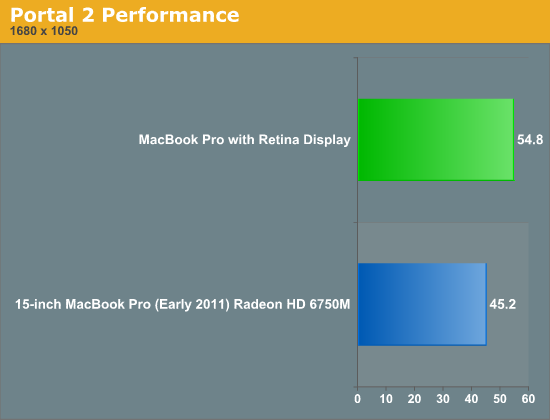
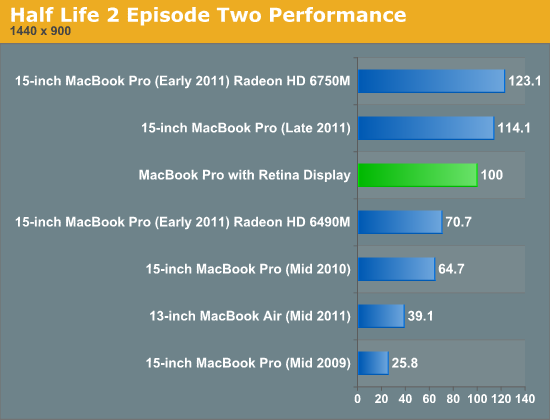
At 1440 x 900 we actually see a regression compared to the 2011 models, but differences in the AMD and NVIDIA GPU drivers alone can account for the difference at this hardly GPU bound setting. Look at what happens once we crank up the resolution:
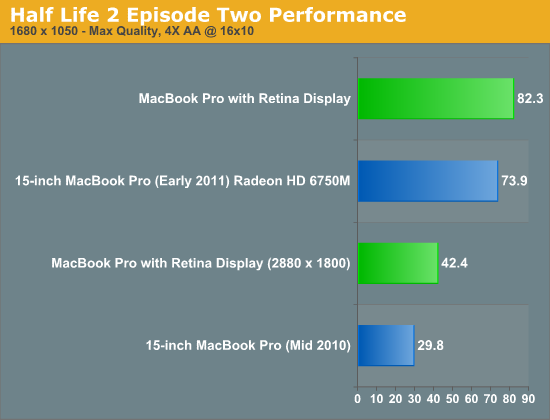
At 1680 x 1050 with 4X AA enabled we see a modest 11% increase in performance over last year's MacBook Pro. As I established earlier however, the rMBP will be able to more consistently deliver this performance over an extended period of time.
What's even more impressive is the 42.4 fps the GT 650M is able to deliver at the rMBP's native 2880 x 1800 resolution. Even though I ran the test with AA enabled I'm pretty sure AA was automatically disabled. At 2880 x 1800 the rMBP is able to outperform the two year old MacBook Pro running at 1680 x 1050. How's that for progress?
While the gains we've shown thus far have been modest at best, Starcraft 2 is a completely different story. Here for whatever reason the IVB + Kepler combination can be up to 2x the speed of last year’s models. I reran the tests both on the older and rMBP hardware to confirm, but the results were repeatable. The best explanation I have is Starcraft 2 is very stressful on both the CPU and GPU, so we could be seeing some thermal throttling on the older SNB + Turks hardware here.
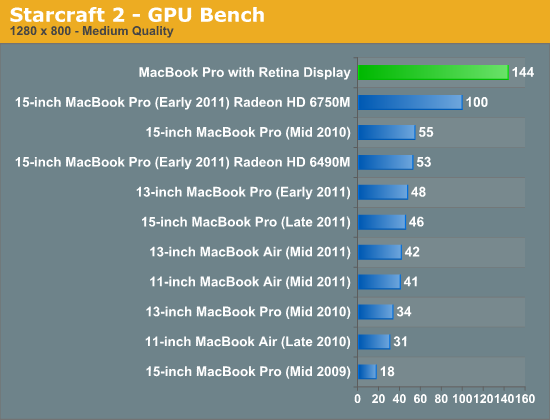
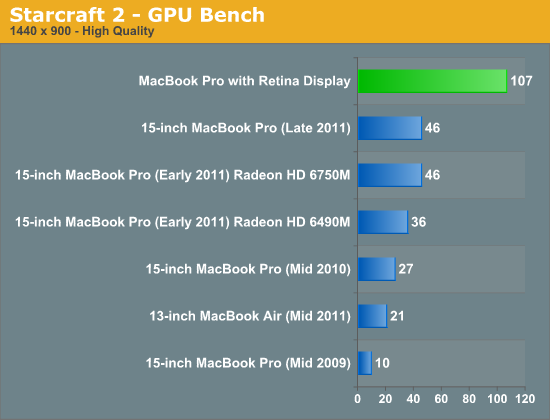
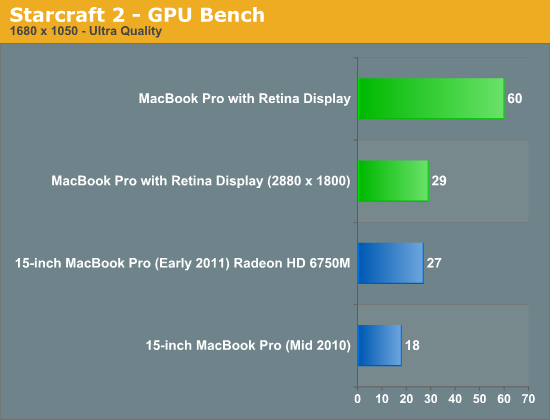
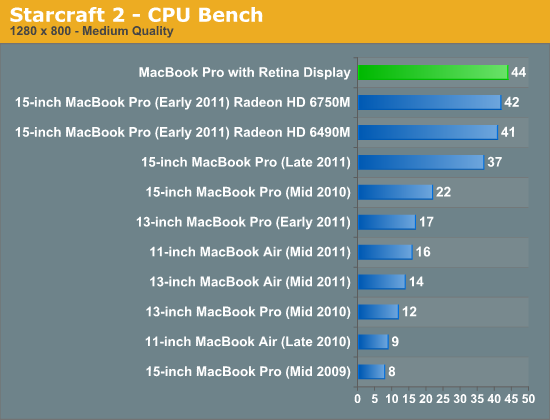
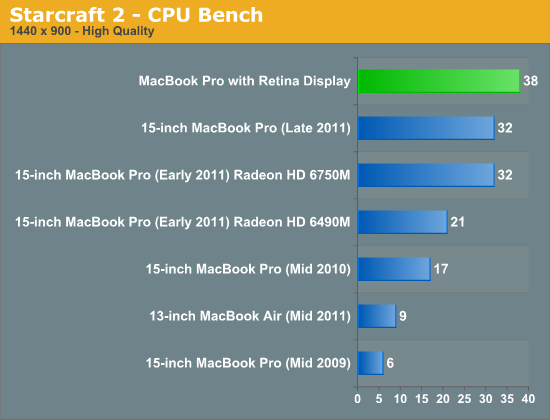

Once again we see playable, although not entirely smooth frame rates at 2880 x 1800. I've also included a screenshot of SC2 at 2880 x 1800 below:
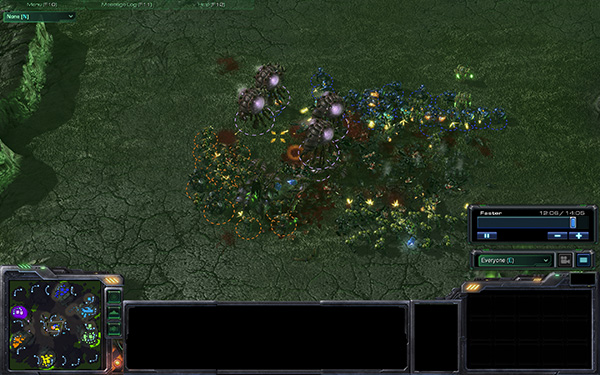
Starcraft 2 at 2880 x 1800, it's playable
Although gaming options continue to be limited under OS X, Diablo 3 is available and finally performs well on the platform thanks to the latest patches. Diablo 3 performance is appreciably better on the GT 650M compared to last year’s 6750M. There’s no FRAPS equivalent under OS X (free advertising to the first eager dev to correct that) so I have to rely on general discussion of performance here. The GT 650M is fast enough to drive the rMBP’s 2880 x 1800 panel at native resolution at playable frame rates, around 18 fps on average. Connected to an external 2560 x 1440 display however the GT 650M is fast enough to deliver around 30 fps in Diablo 3. For what it’s worth, performance under Diablo 3 is far more consistent with the rMBP than with last year’s MacBook Pro. I suspect once again we’re seeing the effects of thermal throttling under heavy CPU/GPU load that has been well mitigated by the move to more power efficient silicon.



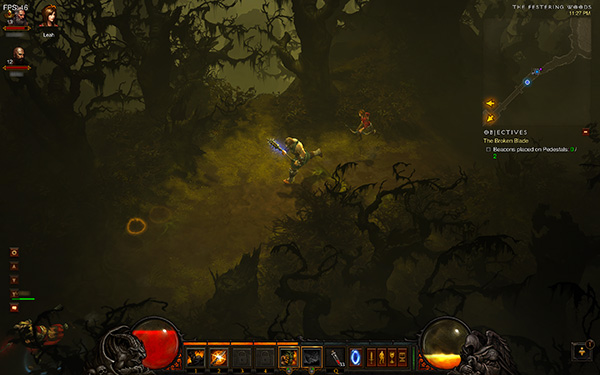








471 Comments
View All Comments
orthorim - Wednesday, June 27, 2012 - link
First of all, PC manufacturers are followers.Second even if they wanted to do it, how are they going to get Microsoft to fully support retina mode? It's evident from the review that Apple's had to do a lot of work on the software side to make it work, and it's still not perfect.
That's Apple's huge advantage: They make hardware and software.
The obstacle for a PC manufacturer would be:
- Get retina displays in quantity (same issue Apple faces - it's doable but by no means easy)
- Get Windows to support retina mode - even if MS were willing, no one knows what amount of effort would be involved. I guess it would be extremely hard to do.
- Get gfx card manufacturers to optimize their drivers to it's fast
All of this takes time and effort...
PubFiction - Friday, August 3, 2012 - link
None of you get it.Super resolution is a by product of OLED. Not of apple, not of anyone else. LG says they can make a panel and apple pays the highest price to have exclusive access fo a while. Are you guys really so stupid that you think apple actually makes these panels?
IF LG does not push IPS displays down in price and up in resolution OLED is quickly going to supplant LCDs as the premium product.
Let me make it clear to the sheeple, PC companies do not give a shit about you or giving you bette stuff until it becomes neccessary to maintain their business, apple happily sold everyone TN panels with low resolution for years while PC makers were offering IPS, wide gamut in work stations laptops.
gorash - Saturday, June 23, 2012 - link
Come on, 1080p screens have existed for some time, and obviously it would move to 4k at some point when it's ready. From the performance standpoint, "Retina" doesn't seem to be all that ready. Maybe in the next year or so, it will be.OCedHrt - Saturday, June 23, 2012 - link
Although the reviewers at Anandtech didn't really like the Z, it is the best laptop I have used to date.solipsism - Saturday, June 23, 2012 - link
Even if Apple can these 27" IPS panels made at a reasonable price and quantity you still have to deal with rending all the pixels in a way that adds more pros than cons.Remember 4k is 4x the pixels of 1080p. Taking the 27" from 2560x1440 to 5120x2880 is going from 3,686,400 px to 14,745,600 px.
DeciusStrabo - Saturday, June 23, 2012 - link
4k isn't 4x the pixels of 1080p. 4k is QFHD, which is 3840x2160 (6.1 million pixels vs. 2 million in 1080p).However, since we already have a spec for 8K (7680x4320 ~ 33 million pixels) things to indeed get interesting soon.
lukarak - Saturday, June 23, 2012 - link
3840x2160 = 8,294,400/
1920x1080 = 2,073,600
--------------------------------
2 x 2 = 4
DanNeely - Saturday, June 23, 2012 - link
4k is a lot more than just quadHD. I wouldn't be surprised if that ends up being the dominant mass market version; but most current 4k cameras record video at 4096x2304/2160.Ohhmaagawd - Saturday, June 23, 2012 - link
"emember 4k is 4x the pixels of 1080p. Taking the 27" from 2560x1440 to 5120x2880 is going from 3,686,400 px to 14,745,600 px."I really doubt it needs to double to be "retina".
Not sure what the sweet spot is, but my gut is somewhere around 3500-4000 pixels wide.
Acanthus - Saturday, June 23, 2012 - link
Apple and their forward looking business sense = buying every factory in the world that can produce high dpi displays. (Yes, they really did that)Anticompetitive =/= "forward thinking"